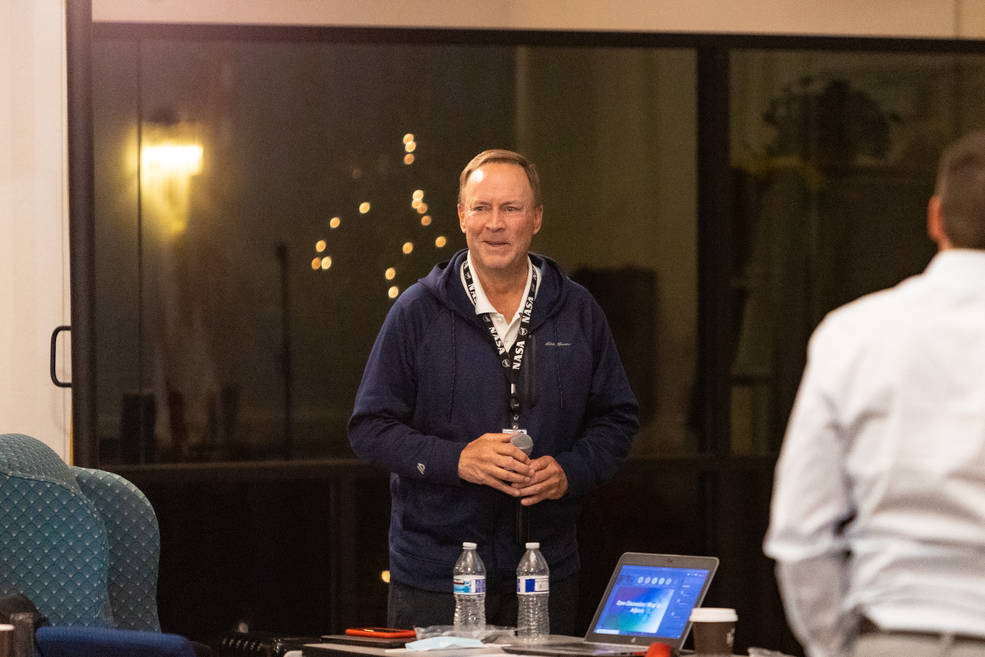On April 19 and 20, the Earth Science Division at NASA Ames Research Center in Silicon Valley hosted the 20th anniversary TFRSAC (Tactical Fire Remote Sensing Advisory Committee).
NASA Ames Hosts 20th Annual TFRSAC Meeting, Highlights Interagency Collaboration for Wildfire Management
On April 19 and 20, the Earth Science Division at NASA Ames Research Center in Silicon Valley hosted the 20th anniversary TFRSAC (Tactical Fire Remote Sensing Advisory Committee) – the first in-person meeting of the group since the advent of the COVID-19 pandemic in 2020. TFRSAC began in 2003 as a joint venture between NASA Ames and the US Forest Service, and has since grown to involve a wide range of public and private-sector entities involved in wildfire strategy and response. It is the only committee of its kind, bringing together science, operations, and field responses to work on tactical solutions for wildfire management in the United States and beyond.
Day 1 focused on the programs and technologies being developed by various agencies and organizations involved in wildfire response, beginning at the federal level in the morning and funneling down to the private sector in the afternoon. Lawrence Friedl, director of the Applied Sciences Program at NASA Headquarters, opened the presentations with a high-level review of the growing interest in wildfire management and response. He carried an optimistic outlook of the potential for further political and financial support for wildfire efforts under the recent PCAST (President’s Council of Advisors on Science and Technology) presentation to President Biden.
Subsequent presenters in the federal sector, representing agencies such as NOAA, NASA Ames, and CALFire, discussed advancements in timely and actionable satellite imagery and remote thermal sensing capabilities, as well as consolidation of data streams for increased efficacy of communication. Representatives from the private sector shared emerging technologies also related to satellite imaging, covering advancements from airborne imaging to data integration frameworks.
Day 2 of TFRSAC centered around the applications of the data and research gathered by many of the technologies outlined on day 1. Speakers from public and private sector organizations gave a series of presentations and lightning talks, highlighting the need for greater efficiency in data management platforms and faster transmission of relevant information to firefighters on the ground. As Fire Management Specialist Kristen Allison put it, “the greatest gift you can give someone fighting a fire is time.”
The reach of TFRSAC stretches beyond national borders, inviting members from around the world. International presenters from the Canadian Forest Service and the Minderoo Foundation (Australia) discussed the impact of TFRSAC on developing their respective wildfire management systems and strategies, as well as potential areas for future collaboration in the face of expected increases in global wildfire activity. From the private sector, the Brazil-based company Quiron presented on potential applications of its data platform, which combines meteorological data with ground and field data to more accurately assess fire risk. Representatives from the Netherlands and Spain were also in attendance.
The unofficial theme of the event was collaboration; a founding value of the committee, many of the presenters emphasized how the advancements they were discussing would not have been possible without information and/or resource sharing between agencies. One example of this was highlighted by NASA Ames’ Peter Mehlitz, who updated the committee on ODIN: a wildfire software architecture that Mehlitz described as “a TFRSAC success story,” born out of the ideas and collaboration fostered at the biannual meetings. In a final address to the attendees, Vince Ambrosia reflected on watching this collaborative effort grow over the past 20 years, starting at under a dozen attendees the first year to a community of over 500 now.
This year’s TFRSAC also included a time to honor Ambrosia, who co-founded TRFSAC in 2003 with Everett Hinkley (USFS) and has been a driving force behind much of its growth and success over the past 20 years. As one of the first scientists at NASA Ames to receive funding for fire research, Ambrosia has an impressive legacy of projects in his 40+ year tenure at Ames, the impact of which is discussed in an article published by Applied Sciences: Vince Ambrosia, a “Man on Fire”
https://appliedsciences.nasa.gov/our-impact/people/vince-ambrosia-man-fi…
Author: Milan Loiacono, NASA Ames Research Center




























